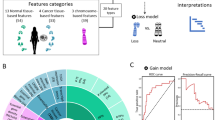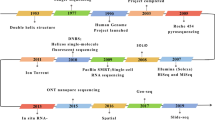Abstract
Tumour cell lines derived from breast cancer patients constitute one of the cornerstones of breast cancer research. To characterise breast cancer cell lines at the genetic level, we have developed a full tiling path bacterial artificial chromosome (BAC) array collection for comparative genomic hybridisation (aCGH). This aCGH BAC collection covers 98% of the entire human genome at a resolution of 40–60 kbp. We have used this platform alongside an in-house produced 17 K cDNA microarray set to characterise the genetic and transcriptomic profiles of 24 breast cancer cell lines, as well as cell types derived from non-diseased breast. We demonstrate that breast cancer cell lines have genomic and transcriptomic features that recapitulate those of primary breast cancers and can be reliably subclassified into basal-like and luminal subgroups. By overlaying aCGH and transcriptomic data, we have identified 753 genes whose expression correlate with copy number; this list comprised numerous oncogenes recurrently amplified and overexpressed in breast cancer (e.g., HER2, MYC, CCND1 and AURKA). Finally, we demonstrate that although breast cancer cell lines have genomic features usually found in grade III breast cancers (i.e., gains of 1q, 8q and 20q), basal-like and luminal cell lines are characterised by distinct genomic aberrations.






Similar content being viewed by others
References
Charafe-Jauffret E, Ginestier C, Monville F et al (2006) Gene expression profiling of breast cell lines identifies potential new basal markers. Oncogene 25:2273–2284. doi:10.1038/sj.onc.1209254
Chin K, DeVries S, Fridlyand J et al (2006) Genomic and transcriptional aberrations linked to breast cancer pathophysiologies. Cancer Cell 10:529–541. doi:10.1016/j.ccr.2006.10.009
Hu Z, Fan C, Oh DS et al (2006) The molecular portraits of breast tumors are conserved across microarray platforms. BMC Genomics 7:96. doi:10.1186/1471-2164-7-96
Neve RM, Chin K, Fridlyand J et al (2006) A collection of breast cancer cell lines for the study of functionally distinct cancer subtypes. Cancer Cell 10:515–527. doi:10.1016/j.ccr.2006.10.008
Perou CM, Sorlie T, Eisen MB et al (2000) Molecular portraits of human breast tumours. Nature 406:747–752. doi:10.1038/35021093
Sorlie T, Tibshirani R, Parker J et al (2003) Repeated observation of breast tumor subtypes in independent gene expression data sets. Proc Natl Acad Sci USA 100:8418–8423. doi:10.1073/pnas.0932692100
Brenton JD, Carey LA, Ahmed AA et al (2005) Molecular classification and molecular forecasting of breast cancer: ready for clinical application? J Clin Oncol 23:7350–7360. doi:10.1200/JCO.2005.03.3845
Rakha EA, Reis-Filho JS, Ellis IO (2008) Basal-like breast cancer: a critical review. J Clin Oncol 26:2568–2581. doi:10.1200/JCO.2007.13.1748
Lacroix M, Leclercq G (2004) Relevance of breast cancer cell lines as models for breast tumours: an update. Breast Cancer Res Treat 83:249–289. doi:10.1023/B:BREA.0000014042.54925.cc
Stamps AC, Davies SC, Burman J et al (1994) Analysis of proviral integration in human mammary epithelial cell lines immortalized by retroviral infection with a temperature-sensitive SV40 T-antigen construct. Int J Cancer 57:865–874. doi:10.1002/ijc.2910570616
Clarke C, Titley J, Davies S et al (1994) An immunomagnetic separation method using superparamagnetic (MACS) beads for large-scale purification of human mammary luminal and myoepithelial cells. Epithelial Cell Biol 3:38–46
O’Hare MJ, Bond J, Clarke C et al (2001) Conditional immortalization of freshly isolated human mammary fibroblasts and endothelial cells. Proc Natl Acad Sci USA 98:646–651. doi:10.1073/pnas.98.2.646
Freshney RI (2005) Culture of animal cells: a manual of basic technique, 5th edn. Wiley-Liss, New York
Arriola E, Lambros MB, Jones C et al (2007) Evaluation of Phi29-based whole-genome amplification for microarray-based comparative genomic hybridisation. Lab Invest 87:75–83. doi:10.1038/labinvest.3700495
Reis-Filho JS, Simpson PT, Jones C et al (2005) Pleomorphic lobular carcinoma of the breast: role of comprehensive molecular pathology in characterization of an entity. J Pathol 207:1–13. doi:10.1002/path.1806
Arriola E, Marchio C, Tan DS et al (2008) Genomic analysis of the HER2/TOP2A amplicon in breast cancer and breast cancer cell lines. Lab Invest 88:491–503. doi:10.1038/labinvest.2008.19
Marchio C, Iravani M, Natrajan R et al (2008) Genomic and immunophenotypical characterization of pure micropapillary carcinomas of the breast. J Pathol 215:398–410. doi:10.1002/path.2368
Marchio C, Natrajan R, Shiu K et al (2008) The genomic profile of HER2-amplified breast cancers: the influence of ER status. J Pathol 216:399–407. doi:10.1002/path.2423
Mackay A, Urruticoechea A, Dixon JM et al (2007) Molecular response to aromatase inhibitor treatment in primary breast cancer. Breast Cancer Res 9:R37. doi:10.1186/bcr1732
Tibshirani R, Hastie T, Narasimhan B et al (2002) Diagnosis of multiple cancer types by shrunken centroids of gene expression. Proc Natl Acad Sci USA 99:6567–6572. doi:10.1073/pnas.082099299
Pierga JY, Reis-Filho JS, Cleator SJ et al (2007) Microarray-based comparative genomic hybridisation of breast cancer patients receiving neoadjuvant chemotherapy. Br J Cancer 96:341–351. doi:10.1038/sj.bjc.6603483
Natrajan R, Little SE, Sodha N et al (2007) Analysis by array CGH of genomic changes associated with the progression or relapse of Wilms’ tumour. J Pathol 211:52–59. doi:10.1002/path.2087
Reis-Filho JS, Drury S, Lambros MB et al (2008) ESR1 gene amplification in breast cancer: a common phenomenon? Nat Genet 40:809–810. doi:10.1038/ng0708-809b (author reply 810–802)
Hicks J, Krasnitz A, Lakshmi B et al (2006) Novel patterns of genome rearrangement and their association with survival in breast cancer. Genome Res 16:1465–1479. doi:10.1101/gr.5460106
Benjamini Y, Hochberg Y (1995) Controlling the false discovery rate: a practical and powerful approach to multiple testing. J R Stat Soc [Ser A] 57:289–300
Jones C, Mackay A, Grigoriadis A et al (2004) Expression profiling of purified normal human luminal and myoepithelial breast cells: identification of novel prognostic markers for breast cancer. Cancer Res 64:3037–3045. doi:10.1158/0008-5472.CAN-03-2028
Jonsson G, Staaf J, Olsson E et al (2007) High-resolution genomic profiles of breast cancer cell lines assessed by tiling BAC array comparative genomic hybridization. Genes Chromosomes Cancer 46:543–558. doi:10.1002/gcc.20438
Savage K, Lambros MB, Robertson D et al (2007) Caveolin 1 is overexpressed and amplified in a subset of basal-like and metaplastic breast carcinomas: a morphologic, ultrastructural, immunohistochemical, and in situ hybridization analysis. Clin Cancer Res 13:90–101. doi:10.1158/1078-0432.CCR-06-1371
Savage K, Leung S, Todd SK et al (2008) Distribution and significance of caveolin 2 expression in normal breast and invasive breast cancer: an immunofluorescence and immunohistochemical analysis. Breast Cancer Res Treat 110:245–256. doi:10.1007/s10549-007-9718-1
Weigelt B, Kreike B, Reis-Filho JS (2008) Metaplastic breast carcinomas are basal-like breast cancers: a genomic profiling analysis. Breast Cancer Res Treat. doi:10.1007/s10549-008-0197-9
Natrajan R, Lambros MB, Rodrigues Pinilla SM, et al (2008) Tiling path genomic profiling of grade III invasive ductal breast cancers. Clin Cancer Res (in press)
Seitz S, Wassmuth P, Plaschke J et al (2003) Identification of microsatellite instability and mismatch repair gene mutations in breast cancer cell lines. Genes Chromosomes Cancer 37:29–35. doi:10.1002/gcc.10196
Schlegel J, Stumm G, Scherthan H et al (1995) Comparative genomic in situ hybridization of colon carcinomas with replication error. Cancer Res 55:6002–6005
Chin SF, Teschendorff AE, Marioni JC et al (2007) High-resolution aCGH and expression profiling identifies a novel genomic subtype of ER negative breast cancer. Genome Biol 8:R215. doi:10.1186/gb-2007-8-10-r215
Adelaide J, Finetti P, Bekhouche I et al (2007) Integrated profiling of basal and luminal breast cancers. Cancer Res 67:11565–11575. doi:10.1158/0008-5472.CAN-07-2536
Bartek J, Bartkova J, Vojtesek B et al (1991) Aberrant expression of the p53 oncoprotein is a common feature of a wide spectrum of human malignancies. Oncogene 6:1699–1703
Hsu HC, Tseng HJ, Lai PL et al (1993) Expression of p53 gene in 184 unifocal hepatocellular carcinomas: association with tumor growth and invasiveness. Cancer Res 53:4691–4694
Lang JC, Borchers J, Danahey D et al (2002) Mutational status of overexpressed p16 in head and neck cancer: evidence for germline mutation of p16/p14ARF. Int J Oncol 21:401–408
Bernard-Pierrot I, Gruel N, Stransky N et al (2008) Characterization of the recurrent 8p11–12 amplicon identifies PPAPDC1B, a phosphatase protein, as a new therapeutic target in breast cancer. Cancer Res 68:7165–7175. doi:10.1158/0008-5472.CAN-08-1360
Gelsi-Boyer V, Orsetti B, Cervera N et al (2005) Comprehensive profiling of 8p11–12 amplification in breast cancer. Mol Cancer Res 3:655–667. doi:10.1158/1541-7786.MCR-05-0128
Ginestier C, Cervera N, Finetti P et al (2006) Prognosis and gene expression profiling of 20q13-amplified breast cancers. Clin Cancer Res 12:4533–4544. doi:10.1158/1078-0432.CCR-05-2339
Reis-Filho JS, Simpson PT, Turner NC et al (2006) FGFR1 emerges as a potential therapeutic target for lobular breast carcinomas. Clin Cancer Res 12:6652–6662. doi:10.1158/1078-0432.CCR-06-1164
Cheng KW, Lahad JP, Kuo WL et al (2004) The RAB25 small GTPase determines aggressiveness of ovarian and breast cancers. Nat Med 10:1251–1256. doi:10.1038/nm1125
Orsetti B, Nugoli M, Cervera N et al (2004) Genomic and expression profiling of chromosome 17 in breast cancer reveals complex patterns of alterations and novel candidate genes. Cancer Res 64:6453–6460. doi:10.1158/0008-5472.CAN-04-0756
Bergamaschi A, Kim YH, Wang P et al (2006) Distinct patterns of DNA copy number alteration are associated with different clinicopathological features and gene-expression subtypes of breast cancer. Genes Chromosomes Cancer 45:1033–1040. doi:10.1002/gcc.20366
Farmer P, Bonnefoi H, Becette V et al (2005) Identification of molecular apocrine breast tumours by microarray analysis. Oncogene 24:4660–4671. doi:10.1038/sj.onc.1208561
Rouzier R, Perou CM, Symmans WF et al (2005) Breast cancer molecular subtypes respond differently to preoperative chemotherapy. Clin Cancer Res 11:5678–5685. doi:10.1158/1078-0432.CCR-04-2421
Brown LA, Hoog J, Chin SF et al (2008) ESR1 gene amplification in breast cancer: a common phenomenon? Nat Genet 40:806–807. doi:10.1038/ng0708-806 (author reply 810–802)
Horlings HM, Bergamaschi A, Nordgard SH et al (2008) ESR1 gene amplification in breast cancer: a common phenomenon? Nat Genet 40:807–808. doi:10.1038/ng0708-807 (author reply 810–802)
Vincent-Salomon A, Raynal V, Lucchesi C et al (2008) ESR1 gene amplification in breast cancer: a common phenomenon? Nat Genet 40:809. doi:10.1038/ng0708-809a (author reply 810–802)
Holst F, Stahl PR, Ruiz C et al (2007) Estrogen receptor alpha (ESR1) gene amplification is frequent in breast cancer. Nat Genet 39:655–660. doi:10.1038/ng2006
Lai PS, Cheah PY, Kadam P et al (2006) Overexpression of RB1 transcript is significantly correlated with 13q14 allelic imbalance in colorectal carcinomas. Int J Cancer 119:1061–1066. doi:10.1002/ijc.21945
Konig A, Happle R, Bornholdt D et al (2000) Mutations in the NSDHL gene, encoding a 3beta-hydroxysteroid dehydrogenase, cause CHILD syndrome. Am J Med Genet 90:339–346. doi:10.1002/(SICI)1096-8628(20000214)90:4<339::AID-AJMG15>3.0.CO;2-5
Ohashi Y, Ueda M, Kawase T et al (2004) Identification of an epigenetically silenced gene, RFX1, in human glioma cells using restriction landmark genomic scanning. Oncogene 23:7772–7779. doi:10.1038/sj.onc.1208058
Reis-Filho JS, Pinheiro C, Lambros MB et al (2006) EGFR amplification and lack of activating mutations in metaplastic breast carcinomas. J Pathol 209:445–453. doi:10.1002/path.2004
Iorns E, Lord CJ, Turner N et al (2007) Utilizing RNA interference to enhance cancer drug discovery. Nat Rev Drug Discov 6:556–568. doi:10.1038/nrd2355
Campbell PJ, Stephens PJ, Pleasance ED et al (2008) Identification of somatically acquired rearrangements in cancer using genome-wide massively parallel paired-end sequencing. Nat Genet 40:722–729. doi:10.1038/ng.128
Albertson DG, Snijders AM, Fridlyand J et al (2006) Genomic analysis of tumors by array comparative genomic hybridization: more is better. Cancer Res 66:3955–3956. doi:10.1158/0008-5472.CAN-05-3611 (author reply 3956)
Acknowledgments
We thank Breakthrough Breast Cancer and Cancer Research UK for their continued support of this work.
Author information
Authors and Affiliations
Corresponding author
Electronic supplementary material
Below is the link to the electronic supplementary material.
Rights and permissions
About this article
Cite this article
Mackay, A., Tamber, N., Fenwick, K. et al. A high-resolution integrated analysis of genetic and expression profiles of breast cancer cell lines. Breast Cancer Res Treat 118, 481–498 (2009). https://doi.org/10.1007/s10549-008-0296-7
Received:
Accepted:
Published:
Issue Date:
DOI: https://doi.org/10.1007/s10549-008-0296-7




